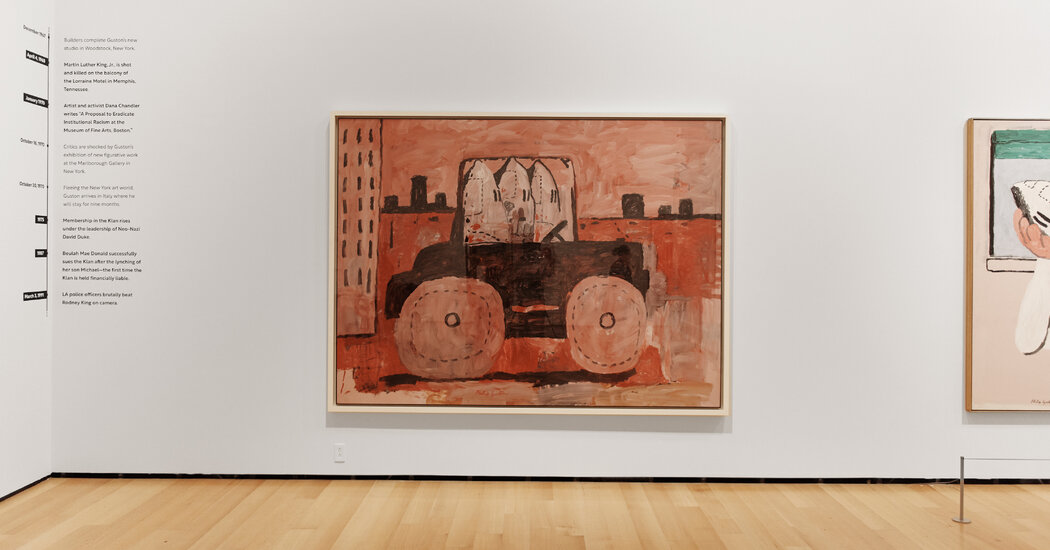

BOSTON — In the summer of 2020, looking over a checklist of images and the installation plan for the upcoming Philip Guston show at the National Gallery of Art in Washington, Kaywin Feldman, who was in her second year as the museum’s director, felt uneasy. How would the cartoonish, hooded Ku Klux Klan figures painted by Guston — who explored racism in his enigmatic, politically charged work — look to visitors amid the pain and the push for racial justice that had just exploded after the killing of George Floyd?
There were no Black curators on the museum’s staff at the time. Feldman consulted employees from across the museum, including educators and security guards, to hear their thoughts. She expressed her misgivings to her counterparts at the three other museums collaborating on the Guston show, who voiced their own doubts. When she told her board that all four directors had concluded the show should be postponed, she mentioned a comment from a Black colleague that had made a particularly strong impression on her: “Looking at more Klan imagery is like cutting another wound in my arm and pouring salt in it. I’m willing to do that, but it needs to be for a bigger reason.”
The museums collaborating on the Guston exhibition — the National Gallery, Tate Modern in London, the Museum of Fine Arts, Boston, and the Museum of Fine Arts, Houston — announced that September that they would postpone the show until 2024 to rethink it, setting off a firestorm as hundreds of prominent artists signed an open letter saying the institutions “fear controversy” and “lack faith in the intelligence of their audience.”
Now the show is set to open here May 1 at the Museum of Fine Arts, Boston, its postponement shortened in response to the outcry. The paintings of the hooded figures are included, along with more historical context; an “Emotional Preparedness” pamphlet from a trauma specialist urging visitors to “identify your boundaries and take care of yourself”; and a detour allowing visitors to bypass the Klan-themed works. The opening has reignited a fierce debate about whether the delay was a troubling indication that museums are shying away from challenging, provocative work in an age of heightened sensitivities, or a healthy sign that they are belatedly confronting the need for change after long failing to diversify their staffs, programming and audiences.
“I really could not see why, at the height of the Black Lives Matter movement, an institution would choose not to exhibit paintings that were a direct response to racism in such a powerful way,” Danny Simmons, an artist and collector who signed the protest letter, said in a recent interview. “I fail to see the downside of showing the work.”
Darren Walker, the president of the Ford Foundation, which contributed $1 million to the exhibition, and a National Gallery trustee who supported the postponement, said the incident exposed “how inadequately museums that show exhibitions on these sensitive matters are managed and how we have to change that.”
“In the future when museums mount shows like this, people of color need to be consulted,” he said. “You’re not asking their permission, you’re not asking their expert advice, you’re just being empathetic to the people who will be affected.”
The directors of the museums involved in the show, “Philip Guston Now,” argue that the critics missed the point of their delay: to ensure that the Guston exhibition was more responsive to the moment.
“We never were going to cancel or censor, and we haven’t,” said Gary Tinterow, the director of the Houston museum. “But what was equally inevitable was a change in the conversation regarding his work.”
Matthew Teitelbaum, the director of the Museum of Fine Arts, Boston, said, “This isn’t about the acceptability of Guston, this is about the hospitality of the museum.”
Critics still question whether a nearly two-year postponement was necessary, and how significant the current changes are.
“I do want to note that plans were already in place at Tate to give ample context to Guston’s early depictions of the K.K.K. and his later hood paintings,” said Mark Godfrey, who was the show’s curator at the Tate Modern in London before he condemned the postponement in an Instagram post, was suspended, and accepted a voluntary buyout.
Godfrey said that Tate curators had consulted with the museum’s Black, Asian and Minority Ethnic Network and planned an anteroom before the hooded paintings to offer context about American history and Guston’s life and career, in which persecution and the Klan itself figured prominently.
Guston’s daughter, Musa Mayer, who had been sharply critical of the decision to postpone the show, said that she came to understand that the dispute was not so much a reflection of her father’s artwork as the challenges confronting museums.
“This was more an issue of the institutions themselves,” she said in an interview, “the museums’ perceived vulnerability in light of all the demonstrations and petitions and other forms of discontent with American museums.”
In 2017, protesters stood for hours at the Whitney Museum of American Art in New York to block visitors from viewing “Open Casket,” a painting of the Black civil rights martyr Emmett Till by the white artist Dana Schutz. That year, the Walker Art Center in Minneapolis removed Sam Durant’s sculpture “Scaffold” — which evoked gallows in American history, including those used to execute members of the Dakota community in 1862 — after protests from the Dakota. Last year’s retrospective of Sophie Taeuber-Arp at the Museum of Modern Art in New York omitted works inspired by Hopi katsina dolls “out of respect for the Hopi and Pueblo peoples.”
Museums had also come under scrutiny for the lack of diversity on their staffs, boards and walls, and how they serve their communities. In 2019, a teacher said middle schoolers on a field trip to the Museum of Fine Arts, Boston, had been subjected to racist taunts — an incident the museum now mentions on the timeline of its Guston exhibition. In 2020, staff members at the Metropolitan Museum of Art, the Guggenheim and the Smithsonian Institution criticized what they described as entrenched racism within their institutions.
Guston was known for challenging works. He began his career in the 1930s as a muralist inspired by the social realism of Diego Rivera. In the 1950s he became a leading Abstract Expressionist before later shifting back to figurative art — the cartoonish bricks, shoes, limbs and self-portraits that became his signature. Widely panned at the time, this late-career phase in recent decades has come to represent Guston’s greatness.
At least two dozen works from that period feature the hoods, which clearly refer to the Klan. Guston, a child of Jewish immigrants who had fled pogroms, had been exposed to Klan violence as a young man in Los Angeles. In the “Philip Guston Now” catalog, published before the postponement, the artist Glenn Ligon interpreted the hoods as Guston’s effort to grapple with not only racism, but also his own complicity.
But during the summer of 2020 — when the pandemic had already delayed the original opening date — Feldman questioned the wisdom of opening without the necessary context or input from people of color. When she started at the National Gallery in 2019, she said, its curatorial staff, leadership team and board was almost all-white, other than one curator who soon retired.
“When the exhibition staff is entirely white, you’re not actually understanding how people perceive the work,” she said. “I’m a white woman of privilege. Just because I have a degree in art history doesn’t mean my feelings matter more or less than those of our wonderful security officers.”
Before the postponement, the National Gallery had convened a “sensitivity group” made up of members beyond the immediate Guston team, the show’s curator, Harry Cooper, said. To rethink the exhibition after the postponement, the museum developed an advisory group with the aid of outside consultants to consider the show’s layout and contextual elements.
“They’re actually doing the work to see how the employees feel,” said Ottis Johnson Jr., a former National Gallery security guard who is now an officer in their union.
The Boston museum also expanded its curatorial team for the show and rethought how it would present the exhibition. The show’s opt-in moments — viewers must open a sliding panel to see newspaper photographs depicting Nazi atrocities and an article about a defaced Guston mural of a Klansman beating a Black person — are efforts “to give visitors agency,” said Ethan Lasser, chairman of the museum’s Art of the Americas department, who was added to the curatorial team. He acknowledged that such devices were “unconventional.”
Rosa Rodriguez-Williams, who was recently hired as the Museum of Fine Arts, Boston’s first senior director of belonging and inclusion, said that “we really centered the visitor — especially the racially marginalized, who may be activated by what they see.”
Some insist that the process the institutions have engaged in has been important and necessary — that it should be the new normal.
“There is a shift you’re starting to see that is directly tied to the Guston show,” said the writer and critic Antwaun Sargent, a director at the Gagosian Gallery. “For a long time the same voices had a say in museums. Now we have to do business differently.”
And some prominent museum leaders insist the Guston controversy has not instilled a new censoriousness. “I don’t think Guston per se caused museums to do a course correction,” said Glenn D. Lowry, the director of the Museum of Modern Art. “It certainly didn’t cause them to say, ‘We’re going to back off of controversial artists or issues.’”
But others worry that the postponement will have a chilling effect on institutions, making them wary of the very thing museums are meant to do: present art that provokes, stimulates and sometimes even affronts.
“What is to be learned is that we cannot look away,” said the gallerist Lucy Mitchell-Innes, who said she recently had an experience with an institution that reversed course on a show featuring one of her artists because of potential audience sensitivity. “I hope it is a cautionary tale.”
Tom Eccles, the executive director of the center for curatorial studies at Bard College, said that the episode had been extraordinary.
“The fits and starts of the Guston show will stand as one of the great aberrations of modern museum times,” he said. “People asked, or at least thought in private, ‘If it can happen to Guston, then who else? Who’s next?’”
